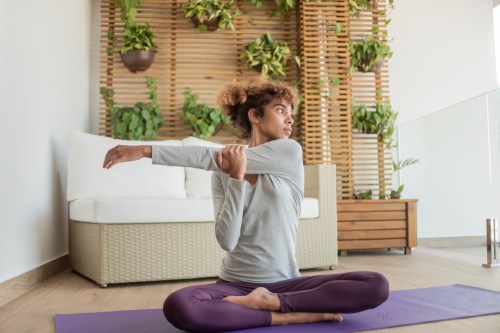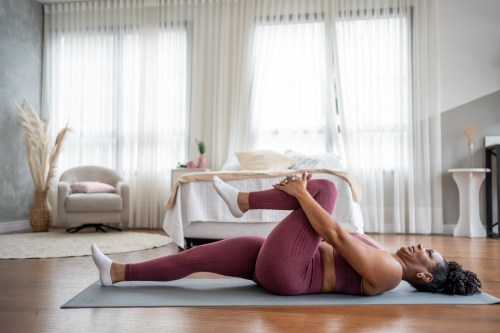Our editors independently select these products. Making a purchase through our links may earn Well+Good a commission
‘I’m a Massage Therapist, and This Is How To Work From Home Without Hurting Your Back’
A massage therapist breaks down the keys to sitting with proper posture while working from home—and how to correct imbalances.

So many aspects of our lives have changed in the past couple of years: our work commutes, our daily routines, our workouts, and—perhaps more unsuspectingly—our posture. Sore back, stiff neck, achy glutes? You’re not alone. Sitting with proper posture has taken a backseat when we’re logging in from our couches and bedrooms.
Experts in This Article
Polly Brasch is a licensed massage therapist and treatment trainer at Rancho Valencia Resort and Spa in San Diego, CA
“I’ve definitely noticed more postural problems among my clients at Rancho Valencia,” says Polly Brasch, a licensed massage therapist and treatment trainer at Rancho Valencia Resort and Spa in San Diego, CA. “Since many of them started working from home, I noticed a big swing in clients having pain in their middle and upper backs.”
A lot of this comes down to not just working at home, but working from home in compromising positions. “A majority of those clients, when asked, admit to using their laptops sitting cross-legged on their comfy sofa, or while lying in bed with their back against the headboard,” says Brasch.
While it may be tempting to get cozy under a blanket on the couch, doing this repeatedly (say, five days a week for months on end) can have serious repercussions. According to Brasch, improper posture can lead to back pain, muscular weakness, and more.
“Postural health plays an integral part in our health and wellness,” says Brasch. “Proper posture keeps blood and lymph moving, and it also helps prevent a sore back from slouching and the imbalances created.” On the other hand, poor posture lets certain muscle groups get stronger while others weaken, she warns. “Sitting all day can also impact digestion, cause fatigue, and make our lymphatic system sluggish, causing puffiness (edema) in our feet and calves. This is why how you sit when you work from home is so important.”
Signs your WFH posture isn’t ideal
There are a few tell-tale signs Brasch sees in clients who let their posture become less-than-ideal during the workday:
1. Dominant-side tightness
“What I see most often is that one side (usually a person’s dominant arm) is much tighter around the shoulder and neck area,” she says. This can lead to pain in those muscles as well as headaches.
2. Stiff traps and shoulders
“When we are using a keyboard or a mouse that is on a desk that’s too high, for example, it makes us engage our upper trapezius and levator scapulae,” says Brasch, speaking about those muscles that stretch across our upper back and up the sides of our neck. “After eight or more hours on a computer, it’s as if you have been doing micro reps, making the muscles fatigued and prone to soreness and injuries.”
3. Back and butt pain
Brasch says she also sees tight lower back muscles, herniated or bulging disks, and tight glutes from working in one unhealthy position for too long.
Sitting with proper posture, step by step
So what can you actually do about this? Brasch notes that her clients who were able to invest in ergonomic chairs and desks showed improvement in their postural health. If you can, she suggests using a sit-stand desk with a hydraulic lift so you can adjust your position throughout the day to appropriate heights for both sitting and standing.
But she readily acknowledges that not everyone has the space or budget to afford the ideal home office setup. Fortunately, even just following a few form cues can help to protect your postural health.
1. Flat surface, elbow level
Whether you’re seated or standing, the best position for your laptop is a flat surface at elbow-level. If you are working from the couch, a lap desk could help. “Use your keyboard and mouse pad at a level where your elbows are bent at a 45-90 degree angle, keeping the wrists and hands in alignment,” says Brasch. “This takes the burden off the shoulders and wrists, and allows good blood and lymphatic flow.”
2. Feet flat on the floor, knees at 90 degrees
“Your chair height should allow your feet to sit flat on the ground, knees at a 90 degree angle,” she says. If you have the means to invest in a more ergonomic chair, Brasch recommends trying out the options in a store to check for fit. “A chair for someone who is 6’4″ is not going to work for someone who is 5’4″,” she says.
3. Sit upright
Don’t ignore what your mother taught you: Sit up straight. “Have your hips and glutes in the back of the seat,” says Brasch. “The backrest should touch your back, more as a reminder to sit up straight than to fully relax into it!” Alternatively, you can sit at the edge of the chair, using your core muscles to keep you upright.
Catch yourself slouching? Strengthen the muscles you need for better posture with this quick Pilates workout:
How to correct damage from poor WFH posture
It’s good to have a gameplan for sitting with proper posture, but what if you’re dealing with painful effects from the past two years of slouching at home?
1. Try massage therapy
If you can, schedule some bodywork. This isn’t just a luxurious treat to unwind—it’s a healthcare treatment and a means of pain management (and correction!). “The more you get massages, the more it trains your muscles to relax faster and respond less to stressful stimuli,” Brasch says. For example, she says, if your shoulders and neck are overly tight, book two massages in a week to address those areas, then reassess. “If you still have a lot of tension, you may need a few more sessions. Once it has subsided, schedule your massage once every three to four weeks for ongoing care.”
2. See a physical therapist
These appointments could be covered by your health insurance, sometimes making them a bit more affordable than massage therapy. “Physical therapy can be a great option, especially when working with specific injuries, like herniated disks, to retrain your muscles and alignment,” says Brasch.
3. Hydrate and take movement breaks
In case you needed another reminder to drink water, “staying hydrated really helps your recovery!” says Brasch. She suggests setting an alarm for every 15 or 20 minutes to stand up and walk around for a few minutes, roll your shoulders, shake out your arms, and drink some water. “After a few times you will automatically start taking those breaks our bodies so desperately need to keep us energized and moving through our day.”
4. Experiment with new wellness treatments
In her job, Brasch is able to see how different clients respond to different treatments. Trend-wise, she says, “I see increasingly more clients booking lymphatic drainage massage, which corresponds with the stagnation that can come from poor posture.” Also popular and massage-therapist recommended? “Body scrubs and bath soaks are great for alleviating inflammation and invigorating or relaxing the nervous system.”
Oh hi! You look like someone who loves free workouts, discounts for cutting-edge wellness brands, and exclusive Well+Good content. Sign up for Well+, our online community of wellness insiders, and unlock your rewards instantly.
Sign Up for Our Daily Newsletter
Get all the latest in wellness, trends, food, fitness, beauty, and more delivered right to your inbox.
Got it, you've been added to our email list.










